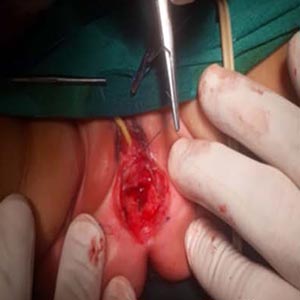Rectovestibular fistula: Which surgical approach is suitable? A randomized controlled trial

Published: April 8 2022
Abstract Views: 2289
PDF: 971
HTML: 236
Appendix: 113
Video 1: 148
Video 2: 129
HTML: 236
Appendix: 113
Video 1: 148
Video 2: 129
Publisher's note
All claims expressed in this article are solely those of the authors and do not necessarily represent those of their affiliated organizations, or those of the publisher, the editors and the reviewers. Any product that may be evaluated in this article or claim that may be made by its manufacturer is not guaranteed or endorsed by the publisher.
All claims expressed in this article are solely those of the authors and do not necessarily represent those of their affiliated organizations, or those of the publisher, the editors and the reviewers. Any product that may be evaluated in this article or claim that may be made by its manufacturer is not guaranteed or endorsed by the publisher.
Similar Articles
- Enrica Caponcelli, Milena Meroni, Giulia Brisighelli, Claudia Rendeli, Emanuele Ausili, Piergiorgio Gamba, Antonio Marte, Barbara Daniela Iacobelli, Laura Lombardi, Ernesto Leva, Paola Midrio, Transanal irrigation (TAI) in the paediatric population: Literature review and consensus of an Italian multicentre working group , La Pediatria Medica e Chirurgica: Vol. 43 No. 1 (2021)
- Carmine Noviello, Mercedes Romano, Letizia Trotta, Giuseppina Rosaria Umano, Alfonso Papparella, Are the complications after laparo-assisted endo-rectal pull-through for Hirschsprung disease related to the change of the anal tone? , La Pediatria Medica e Chirurgica: Vol. 46 No. 1 (2024)
- Alessandro Calisti, Diaaeldinn Yaseen Salman, Kibreab Belay, Andrea Mombo, Boniphace Tresphory, Giovanni Giuliani, Martina Sertori, Gian Battista Parigi, The hidden burden of Pediatric urology in Sub-Saharan Africa: an analysis of hospital admission data from three East African Health Centres , La Pediatria Medica e Chirurgica: Vol. 46 No. 1 (2024)
- Alessandro Calisti, Kibreab Belay, Andrea Mombo, Faisal Abdelgalil Nugud, Diaaeldinn Yaseen Salman, Pierluigi Lelli Chiesa, Presentations of bladder exstrophy in a resource-limited setting and the role of Mainz II continent diversion for late referrals or failed primary closures: a multicentric report , La Pediatria Medica e Chirurgica: Vol. 45 No. 2 (2023)
- Giovanna Stringari, Giulia Barbato, Matteo Zanzucchi, Maddalena Marchesi, Giuseppe Cerasoli, Bertrand Tchana, Alessandro Gritti, Valeria Boccaletti, Alfonsa Anna Lombardi, Nicola Carano, Propranolol treatment for infantile hemangioma: a case series of sixty-two patients , La Pediatria Medica e Chirurgica: Vol. 38 No. 2 (2016)
- Agostino Berio, Giacomo Garlaschi, Giuseppe Mangiante, Attilia Piazzi, Oculo-auriculo-vertebral spectrum with craniosynostosis and osteo-cartilagineous multiple defects: a diffuse chondro-membranous-osteo-dysplasia , La Pediatria Medica e Chirurgica: Vol. 37 No. 3 (2015)
- Cosimo Bleve, Valeria Bucci, Maria Luisa Conighi, Francesco Battaglino, Lorenzo Costa, Lorella Fasoli, Elisa Zolpi, Salvatore Fabio Chiarenza, Horseshoe kidney and uretero-pelvic-junction obstruction in a pediatric patient. Laparoscopic vascular hitch: A valid alternative to dismembered pyeloplasty? , La Pediatria Medica e Chirurgica: Vol. 39 No. 4 (2017)
- Eugenia Piro, Fabiola Colombini, Marta Brugnoni, Daniele Perilli, Laura Caterina Abati, Veronica Zocca, Lucia Vallieri, Antonio D'Alessio, Ureteropelvic junction obstruction in children by polar vessels: histological examination result , La Pediatria Medica e Chirurgica: Vol. 45 No. 1 (2023)
- Agostino Berio, Attilia Piazzi, Carlo Enrico Traverso, Kearns-Sayre syndrome with facial and white matter extensive involvement: a (mitochondrial and nuclear gene related?) neurocristopathy? , La Pediatria Medica e Chirurgica: Vol. 39 No. 4 (2017)
- Salvatore Arena, Tiziana Russo, Patrizia Perrone, Carmelo Romeo, Operative cystoscopy in the neonatal period , La Pediatria Medica e Chirurgica: Vol. 38 No. 3 (2016)
1-10 of 47
Next
You may also start an advanced similarity search for this article.









